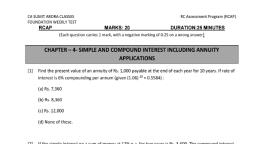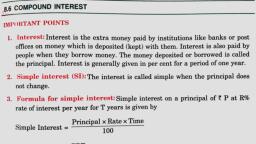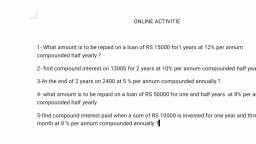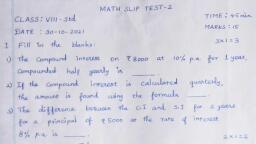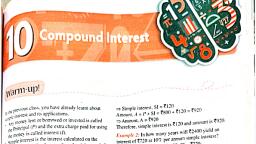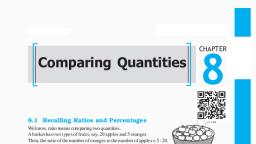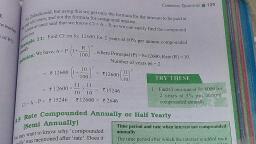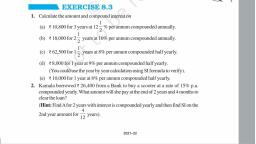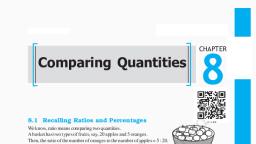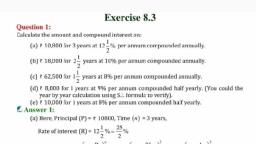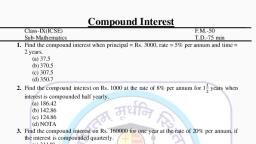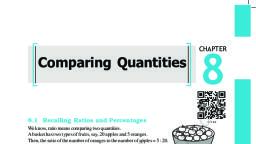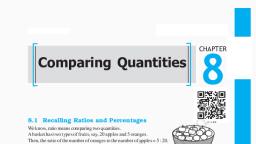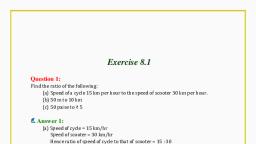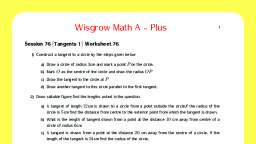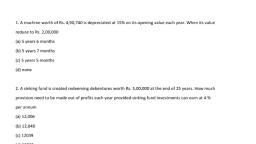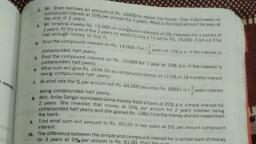Page 1 :
—— is, 8.6 COMPOUND INTEREST, , , , , , [IMPORTANT POINTS, , 1. Interest: Interest is the extra money paid by institutions like banks or post, offices on money which is deposited (kept) with them. Interest is also paid by, people when they borrow money. The money deposited or borrowed is called, the principal. Interest is generally given in per cent for a period of one year., , 2. Simple interest (SI): The interest is called simple when the principal does, not change., , 3. Formula for simple interest: Simple interest on a principal of = P at R%, rate of interest per year for T years is given by, , ; Principal x Rate x Time, Simple Interest = T0900., , PRT, or, SI = 100°, , 4. Amount:Amount = Principal + Simple Interest, (A) (P) (SD
Page 2 :
| 8.7 DEDUCING A FORMULA FOR COMPOUND INTEREST, , , , R n, = 1+—, A rf +a, , where P = Principal, R = Rate of interest per annum compounded annually, n = Number of years, A = Amount, CI=A-P
Page 3 :
[By RATE COMPOUNDED ANNUALLY OR HALF YEARLY (SEMPARNUALLY) jl, , The word annually mentioned after the rate means that the interest is charged, at the end of every year, whereas rate is given for one year., , We could also have interest rates compounded half yearly or quarterly. This, means that the rate for one half year (i.e., 6 months) is half of the rate given for one, year and the time period is of two half years because interest is charged twice a year., , So ifa sum of ¥ 50,000 is taken for 1 year at 10% p.a. compounded semi-annually,, it means time period = 2 half years (i.e., 1 x 2) and rate = 5 x 10% = 5%., , Note: 1 The time period for which the interest is calculated and added each time to, form a new principle is called the conversion period or time period., , Note: 2 If interest is compounded half yearly, then there are two conversion periods in, 4 year each after 6 months. In such situations, we compute the interest two times. So, time, Period becomes twice and rate becomes half of the annual rate., , Note: 3 If interest is compounded quarterly, a year each after 3 months. In such situations a, period becomes four times and rate becomes one:, , then there are four conversion periods in, compute the interest four times. So, time, fourth of the annual rate.
Page 4 :
——, g RATE COMPOUNDED ANNUALLY OR HALF YEARLY (SEMI-ANNUALLY), a, , The word annually mentioned after the rate means that the interest is charged, at the end of every year, whereas rate is given for one year., , We could also have interest rates compounded half yearly or quarterly. This, means that the rate for one half year (i.e., 6 months) is half of the rate given for one, year and the time period is of two half years because interest is charged twice a year., , So ifa sum of f 50,000 is taken for 1 year at 10% p.a. compounded semi-annually,, , it means time period = 2 half years (i.e., 1 x 2) and rate = - x 10% = 5%., , Note: 1 The time period for which the interest is calculated and added each time to, form a new principle is called the conversion period or time period., , Note: 2 If interest is compounded half yearly, then there are two conversion periods in, ayear each after 6 months. In such situations, we compute the interest two times. So, time, period becomes twice and rate becomes half of the annual rate., , Note: 3 If interest is compounded quarterly, then there are four conversion periods in, a year each after 3 months. In such situations, we compute the interest four times. So, time, period becomes four times and rate becomes one-fourth of the annual rate., , a eee mers
Page 5 :
Se, , [is APPLICATIONS OF COMPOUND INTEREST FORMULA 2, , , , , , We use compound interest formula to find, (i) Increase (or decrease) in population., (ii) The growth of a bacteria if the rate of growth is known., , (iii) The value of an item, if its price increases or decreases in the intermediate, years., Note: For increase, R is positive and for decrease, R is negative.





















